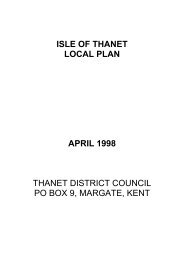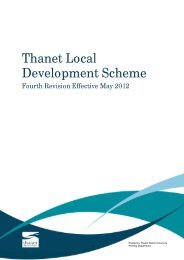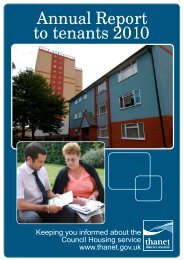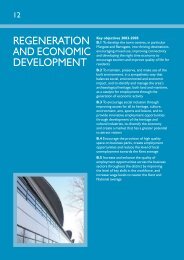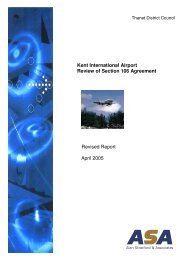HMOs and Student Accommodation - Thanet District Council
HMOs and Student Accommodation - Thanet District Council
HMOs and Student Accommodation - Thanet District Council
Create successful ePaper yourself
Turn your PDF publications into a flip-book with our unique Google optimized e-Paper software.
<strong>Thanet</strong> <strong>District</strong> <strong>Council</strong><br />
Topic Paper<br />
Houses in Multiple<br />
Occupation <strong>and</strong><br />
<strong>Student</strong><br />
<strong>Accommodation</strong><br />
Background document to<br />
<strong>Thanet</strong> Local Plan<br />
May 2013
Contents<br />
1) INTRODUCTION AND BACKGROUND<br />
2) POLICY CONSIDERATIONS<br />
3) CURRENT SITUATION & ISSUES<br />
4) STUDENT ACCOMMODATION<br />
5) BASELINE POLICY OPTION<br />
6) ALTERNATIVE OPTIONS FOR CONSIDERATION/CONSULTATION.<br />
ANNEX 1 - SAVED POLICY FROM 2006 LOCAL PLAN
1) INTRODUCTION AND BACKGROUND<br />
1.1 This paper addresses accommodation in the form of dwelling houses<br />
occupied by unrelated individuals sharing basic amenities. Properties providing such<br />
non-self contained accommodation are often referred to as Houses in Multiple<br />
Occupancy/Occupation (HMO) <strong>and</strong> this term is applied in this paper.<br />
1.2 A fundamental objective of the <strong>Council</strong> is to achieve mixed, confident <strong>and</strong><br />
sustainable communities. It is anticipated that policy will need to safeguard <strong>and</strong><br />
increase the supply of family homes overall <strong>and</strong> continue to tackle areas where the<br />
type <strong>and</strong> quality of housing stock is fuelling deprivation <strong>and</strong> transience.<br />
1.3 The <strong>Council</strong> recognises that where a good st<strong>and</strong>ard of accommodation is<br />
provided, well managed HMO’s can provide a valuable source of affordable<br />
accommodation for people on low incomes including those starting off in the<br />
economy as young professionals. Shared accommodation also contributes to<br />
meeting local dem<strong>and</strong> for student accommodation.<br />
1.4 <strong>Thanet</strong> has a substantial supply of properties around its coastal towns that<br />
are physically conducive to shared occupation. However, existing HMO's in the<br />
district are often low quality accommodation <strong>and</strong> particularly when poorly managed<br />
can result in neighbourhood disturbance, fear of crime, transience <strong>and</strong> a community<br />
imbalance. This can be compounded where such accommodation is clustered as in<br />
the case of Cliftonville West Renewal Area. Specific policy initiatives <strong>and</strong><br />
interventions are being focused in that area to comprehensively redress<br />
concentrations of private rented housing characterised by poor st<strong>and</strong>ards of<br />
accommodation <strong>and</strong> management.<br />
1.5 The following paper assesses the issues above in more detail before<br />
considering planning policy options.
2) POLICY CONSIDERATIONS<br />
Context<br />
National Planning Policy<br />
2.1 In promoting sustainable development Government expects the planning<br />
system to support strong, vibrant <strong>and</strong> healthy communities by providing the supply of<br />
housing required to meet the needs of present <strong>and</strong> future generations. National<br />
Planning Policy as set out in Government’s National Planning Policy Framework,<br />
expects local planning authorities to deliver a wide choice of high quality homes,<br />
widen opportunities for home ownership <strong>and</strong> create sustainable, inclusive <strong>and</strong> mixed<br />
communities.<br />
Strategic Housing Market Assessment<br />
2.2 The East Kent Strategic Housing Market Assessment (SHMA) contains<br />
information on the housing needs in the area including the scale, mix <strong>and</strong> range of<br />
tenures the local population is likely to need. This provides key baseline information<br />
for the <strong>Council</strong>’s Local Plan <strong>and</strong> Housing Strategy. A relevant key conclusion is that<br />
while demographic projections suggest a solid dem<strong>and</strong> for smaller homes, the make<br />
up of the housing stock is such that policy should focus on rebalancing it by<br />
incentivising provision of family homes <strong>and</strong> controlling “flatting” of larger homes.<br />
Reflecting ambitions for regeneration <strong>and</strong> economic development the SHMA<br />
identifies a role for housing to provide appropriate <strong>and</strong> attractive housing products for<br />
higher earners <strong>and</strong> to ensure young families can stay.<br />
2.3 The SHMA notes that Houses in Multiple Occupation can help meet the<br />
needs of various groups requiring affordable housing, but often have problems<br />
(associated with the condition of the accommodation <strong>and</strong> management st<strong>and</strong>ards).<br />
It encourages continued enforcement of high st<strong>and</strong>ards for such accommodation.<br />
Housing Strategy<br />
2.4 The <strong>Council</strong>’s 2012-2016 housing strategy seeks to deliver good quality <strong>and</strong><br />
affordable homes across all tenures in support of sustainable communities <strong>and</strong><br />
economic development aspirations. It identifies the need for greater emphasis on<br />
delivering more family homes, <strong>and</strong> creative solutions to tackling the substantial need<br />
for affordable housing.<br />
2.5 While recognising that cheaper housing in the private rented sector fulfils a<br />
need, the strategy proposes to drive up st<strong>and</strong>ards of such accommodation,<br />
vigorously tackling poor quality accommodation where necessary.<br />
2.6 The need to tackle areas suffering concentrations of poor quality private<br />
rented accommodation including HMO’s is emphasised in the Strategy which cites<br />
the “Live Margate” project as a major targeted intervention (in Cliftonville West<br />
Renewal Area) to address these issues <strong>and</strong> restore an inclusive <strong>and</strong> decently housed<br />
community. The Strategy’s action plan includes reviewing the impact of selective<br />
HMO licensing together with monitoring of licensed HMO’s.
2.7 The strategy also seeks to support provision of good quality accommodation<br />
for students associated with the important functions of the Broadstairs campus of<br />
Christchurch University.<br />
Current planning policy position<br />
2006 Local Plan<br />
2.8 Saved Policy H11 of the 2006 Local Plan addresses non-self contained<br />
accommodation. It reflects the <strong>Council</strong>’s position in not wishing to encourage<br />
proliferation of such accommodation as a permanent measure but recognising that it<br />
can provide a source of cheap rented accommodation. The Policy also recognises<br />
that such accommodation can generate various problems <strong>and</strong> that this may result<br />
from intensity of occupation, management of the building, nature of the area, type of<br />
building <strong>and</strong> concentration of similar uses in the vicinity. The Policy therefore sets<br />
out criteria to judge applications on the basis of impact on local character <strong>and</strong><br />
amenity; in particular arising from noise, disturbance, visual impact <strong>and</strong> or<br />
concentration of such uses together with refuse <strong>and</strong> parking considerations. The<br />
Policy <strong>and</strong> its supporting text is reproduced at Annex 1<br />
2.9 So concerned did the <strong>Council</strong> become about the effect of concentrations of<br />
single bed flats <strong>and</strong> non self contained accommodation <strong>and</strong> their association with a<br />
deprivation cycle in Cliftonville West Renewal Area (referred to above) that it adopted<br />
an interim planning policy <strong>and</strong> subsequent Development Plan Document for that area<br />
restricting further accommodation of this type. In addition, the underlying factors<br />
fuelling the area’s problems of transience <strong>and</strong> deprivation are being tackled through a<br />
multi agency housing intervention initiative, which includes selective licensing.<br />
“Article 4” Direction<br />
2.10 In 2010 Government introduced new legislation signifying that planning<br />
permission would no longer be required to change the use of a dwelling house to a<br />
HMO for up to 6 unrelated people. In 2011 the <strong>Council</strong> approved an “article 4”<br />
direction so that planning permission would still be required for such change<br />
anywhere within the <strong>District</strong>.<br />
2.11 Key considerations cited in justifying <strong>and</strong> recommending the direction were:<br />
<br />
<br />
Baseline evidence supporting the Cliftonville DPD has demonstrated a<br />
correlation between small flats, HMO’s <strong>and</strong> cheap rented accommodation in<br />
poor condition (prevalent in that area) <strong>and</strong> the importation of vulnerable<br />
people.<br />
The Strategic Housing Market Assessment recommends policies supporting<br />
intervention to maximise the potential of the existing stock, in particular<br />
rebalancing the stock to incentivise the provision of family homes <strong>and</strong><br />
controlling expansion of flatting larger homes.
Percentage of total dwellings<br />
Percentage of Total Dwellings<br />
3) CURRENT SITUATION & ISSUES<br />
3.1 It is only possible to estimate the number of HMO’s in the <strong>District</strong>.<br />
3.2 The 2001 census showed that <strong>Thanet</strong> had the highest percentage of shared<br />
dwellings in Kent. These were unevenly distributed across <strong>Thanet</strong>’s wards typically<br />
where the age <strong>and</strong> size of the dwelling stock is physically conducive to multiple<br />
occupancy. (The 2001 census definition of a shared dwelling is essentially that not<br />
all rooms (including bathroom <strong>and</strong> toilet) are behind a door that only that household<br />
can use).<br />
% Shared Dwellings (2001 Census)<br />
0.18<br />
0.16<br />
0.14<br />
0.12<br />
0.1<br />
0.08<br />
0.06<br />
0.04<br />
0.02<br />
0<br />
<strong>Thanet</strong><br />
Shepway<br />
Tunbridge Wells<br />
Maidstone<br />
Canterbury<br />
Kent average<br />
Dover<br />
Ashford<br />
Swale<br />
Sevenoaks<br />
Dartford<br />
Gravesham<br />
Tonbridge & Malling<br />
% Shared Dwellings (2001 Census)<br />
0.9<br />
0.8<br />
0.7<br />
0.6<br />
0.5<br />
0.4<br />
0.3<br />
0.2<br />
0.1<br />
0<br />
Cliftonville West<br />
Central Harbour<br />
Margate Central<br />
Eastcliff<br />
Bradstowe<br />
Westbrook<br />
Nethercourt<br />
Sir Moses Montefiore<br />
Salmestone<br />
Westgate on Sea<br />
St. Peters<br />
Viking<br />
Beacon Rd<br />
Birchington North<br />
Birchington South<br />
Cliffsend & Pegwell<br />
Cliftonville East<br />
Dane Valley<br />
Garlinge<br />
Kingsgate<br />
Newington<br />
Northwood<br />
<strong>Thanet</strong> Villages<br />
Source 2001 census Crown copyright 2003. Crown copyright material is reproduced with the permission of the<br />
Controller of HMSO.
Percentage of total stock<br />
Sevenoaks<br />
Tonbridge<br />
<strong>and</strong> Malling<br />
Dartford<br />
Swale<br />
Ashford<br />
Gravesham<br />
Maidstone<br />
Tunbridge<br />
Wells<br />
Dover<br />
Canterbury<br />
<strong>Thanet</strong><br />
Shepway<br />
3.3 The 2011 Census indicates <strong>Thanet</strong> had the second highest percentage of<br />
shared dwellings in Kent.<br />
% Shared Dwellings (2011 census)<br />
0.18<br />
0.16<br />
0.14<br />
0.12<br />
0.1<br />
0.08<br />
0.06<br />
0.04<br />
0.02<br />
0<br />
Adapted from data from the Office for National Statistics licensed under the Open<br />
Government Licence v.1.0. Source 2011 census Table KS401EW<br />
3.4 Definitions of HMO vary between those applied for planning purposes <strong>and</strong><br />
under the licensing scheme administered by the <strong>Council</strong>’s Housing team. However,<br />
information from the 2008 stock condition survey of 1,000 sample properties<br />
suggests <strong>Thanet</strong> may at that time have had in the order of 770 HMO’s as defined for<br />
planning purposes.<br />
Recent Activity<br />
3.5 During 2012 the number of applications for new HMO accommodation has<br />
diminished, possibly on the expectation that the <strong>Council</strong> will take a strong line<br />
(presumably as a result of the Article 4 direction). However, Policy H11 which<br />
remains in effect does not infer this. Moreover applications necessitated by the<br />
direction would not incur fees. On this basis, it may also be that property owners are<br />
in any event less keen to pursue multiple occupation at the present time.<br />
3.6 In the year from April 2012 to April 2013 there were ten planning applications<br />
to change dwellings to HMO’s of which four were retrospective. In that same period<br />
there were also three applications to change HMO’s to single dwellings. Two of the<br />
applications to change dwellings to HMO’s related to single dwelling houses in<br />
proximity to the Broadstairs campus of Canterbury Christ Church University. (CCCU)<br />
The applications sought to change these to HMO style accommodation, each for up<br />
to four occupants. The applications although not specifying occupation by students<br />
were accompanied by a supporting letter from CCCU outlining the need for<br />
accommodation for 2 nd <strong>and</strong> 3 rd year students <strong>and</strong> expressing the hope that the<br />
<strong>Council</strong> will be supportive of the growth of private residences for students. One of<br />
these applications was approved, while the other was refused due to its likely impact
on the area’s character <strong>and</strong> amenity in terms of noise, disturbance <strong>and</strong><br />
inconvenience to road users as a result of the property’s size, close relationship with<br />
neighbouring properties <strong>and</strong> lack of suitable arrangements for car parking.<br />
3.7 The current wording of Policy H11 has enabled applications to be judged on<br />
the basis of relevant considerations applying on a case by case basis.<br />
4) STUDENT ACCOMMODATION<br />
4.1 The Broadstairs campus of Canterbury Christ Church University generates<br />
dem<strong>and</strong> for local living accommodation for students ordinarily resident outside the<br />
district. For first year students who cannot be accommodated within available<br />
capacity of its halls of residence the University arranges student accommodation in<br />
the private housing stock by means of a head lease arrangement. This includes a<br />
contract between the University <strong>and</strong> student covering management responsibilities<br />
<strong>and</strong> student obligations in relation to anti social behaviour, breach of which may<br />
result in early termination of occupation.<br />
4.2 Use of private sector homes is also made to accommodate needs of students<br />
in year two or above. While this is not its direct responsibility, the University works to<br />
encourage such l<strong>and</strong>lords to foster good management practice.<br />
4.3 Private sector student accommodation is typically in the form of a HMO where<br />
amenities such as kitchens are shared. In some districts such accommodation has<br />
caused concerns including disturbance, car parking issues <strong>and</strong> transience<br />
compounded by concentration <strong>and</strong> recognition that while student accommodation<br />
places a burden on local services it is exempt from <strong>Council</strong> tax.<br />
4.4 In 2012 the University’s representatives estimated that at any time there are<br />
about 300 students in private accommodation in <strong>Thanet</strong>, <strong>and</strong> noted that while<br />
proximity to the campus is a consideration, such accommodation is typically dotted<br />
about. <strong>Council</strong> tax records (2013) indicate that some properties in the vicinity of the<br />
campus (such as on the Wimpey Estate) are used as student lets. Broadstairs <strong>and</strong><br />
Ramsgate are reportedly the most popular locations with students; with Cliftonville<br />
<strong>and</strong> Margate evidently not popular. In October 2012 all twelve properties providing<br />
head lease accommodation were located either in Ramsgate or Broadstairs at some<br />
distance from the Broadstairs University campus.<br />
4.5 In 2012 applications were received to change two 2-storey suburban<br />
properties in Broadstairs from single dwellings to Multiple Occupation each for up to<br />
4 people. Both properties are in proximity to the Broadstairs Campus, <strong>and</strong> the<br />
applications included a supporting letter from the University requesting that such<br />
applications be considered having regard to ongoing dem<strong>and</strong> for private student<br />
accommodation <strong>and</strong> the University’s work with l<strong>and</strong>lords to encourage a supply of<br />
good quality rented accommodation to meet it. As indicted in the preceding section,<br />
one of these applications was refused on the basis of impact on the character <strong>and</strong><br />
amenity of the neighbouring area.<br />
4.6 The presence of Christ Church University Campus <strong>and</strong> East Kent College is<br />
highly important for delivering the skills required by the local workforce, meeting the<br />
expectations of existing <strong>and</strong> potential employers, <strong>and</strong> stemming out-migration of<br />
young people. Supporting the function of our higher <strong>and</strong> further education<br />
establishments must include recognising the desirability of meeting dem<strong>and</strong> arising
for suitably located, affordable <strong>and</strong> decent accommodation for students. At the<br />
same time it is essential to ensure that such dem<strong>and</strong> does not result in undue<br />
concentration of non self contained accommodation in order to avoid local<br />
disturbance <strong>and</strong> maintain a balanced <strong>and</strong> settled community.<br />
4.7 Engagement with the University reveals its ongoing commitment to its<br />
Broadstairs Campus, with potential to reinforce <strong>and</strong> diversify it. This may include the<br />
prospect of constructing additional student accommodation to effectively increase<br />
capacity beyond that of its existing halls of residence. However, the impact of the<br />
national picture in respect of the funding regime <strong>and</strong> student fees for higher<br />
education will influence potential intake <strong>and</strong> it is not currently possible to predict<br />
future student numbers. In 2013 the University’s representatives did not anticipate<br />
any significant foreseeable rise in dem<strong>and</strong> for private sector based student<br />
accommodation.
5) BASELINE POLICY OPTION<br />
5.1 The circumstances outlined in this paper suggest that the existing 2006 Local<br />
Plan saved criteria based policy (H11) remains essentially appropriate in<br />
respect of both HMO’s in general <strong>and</strong> (although the policy does not currently<br />
refer to it specifically) in relation to HMO type student accommodation.<br />
Concentrations of HMO’s <strong>and</strong> their attendant issues in Cliftonville West<br />
Renewal Area are being addressed through specific policies in the<br />
Development Plan document, <strong>and</strong> it is anticipated that until such time as<br />
these issues have been addressed these policies should continue alongside<br />
H11.<br />
5.2 It is suggested that subject to amendments to the existing supporting text<br />
(amendments to text set out in italics below) saved Policy H11 might be<br />
considered as a baseline policy option. Section 6 outlines possible alternative<br />
approaches for consideration <strong>and</strong> consultation.<br />
Policy H11 - Non-self Contained Residential <strong>Accommodation</strong><br />
In considering applications to establish or regularise non-self contained<br />
residential accommodation or before instigating enforcement proceedings<br />
under planning powers to require cessation of such use, account will be taken<br />
of:<br />
1. The likely or experienced effect of the use on the character <strong>and</strong><br />
amenity of the locality resulting from noise*, disturbance <strong>and</strong> visual<br />
impact<br />
2. Whether the proposed or unlawful use would result or has resulted in<br />
an intensification or concentration of such uses to a level which is<br />
detrimental to the amenity <strong>and</strong> character of the neighbourhood<br />
including in relation to the considerations set out in (1) above;<br />
3. The adequacy of provision <strong>and</strong> suitability of arrangements for car<br />
parking on site or the likely or experienced impact of parking needs<br />
being met on street <strong>and</strong><br />
4. The suitability of arrangements for dustbin storage <strong>and</strong> rubbish<br />
collection<br />
Where it is proposed to grant consent/not pursue enforcement action, a legal<br />
agreement may be sought to restrict the number of persons accommodated<br />
within the premises <strong>and</strong> to secure arrangements for maintaining the building<br />
<strong>and</strong> gardens to an acceptable visual condition.<br />
* Noise problems generated by particular individuals in non-self contained residential<br />
accommodation are essentially a management matter. In considering regularisation<br />
of non-self contained accommodation, the <strong>District</strong> <strong>Council</strong> will have regard only to the<br />
extent that noise is generated as a result of the nature of that use, i.e. resulting from<br />
intensity of occupation <strong>and</strong> living arrangements.
(Supporting text)<br />
i) <strong>Accommodation</strong> within a building can be regarded as non-self contained where<br />
unrelated households share one or more facilities, e.g. bathroom, <strong>and</strong>/or kitchen.<br />
Houses in Multiple Occupation (HMO's) are an example where a high degree of<br />
sharing of facilities is typical, <strong>and</strong> where living arrangements, being more intense<br />
than single family occupation, can give rise to noise, nuisance, more callers, a higher<br />
parking requirement <strong>and</strong> visual deterioration of buildings <strong>and</strong> gardens. While the The<br />
<strong>District</strong> <strong>Council</strong> does not wish to encourage proliferation of <strong>HMOs</strong> as a permanent<br />
measure, it but does recognise that such sharing arrangements can, where<br />
accommodation is of good quality, provide a suitable source of affordable cheap<br />
rented accommodation, <strong>and</strong> are typically suited to the needs of small households.<br />
Such arrangements are often suited to the needs of students requiring private sector<br />
accommodation.<br />
ii) The presence of Christ Church University Campus <strong>and</strong> East Kent College is highly<br />
important for delivering the skills required by the local workforce, meeting the<br />
expectations of existing <strong>and</strong> potential employers, <strong>and</strong> stemming out-migration of<br />
young people. Thus the <strong>Council</strong> strongly supports their function <strong>and</strong> recognises the<br />
desirability of meeting dem<strong>and</strong> arising for suitably located, affordable <strong>and</strong> decent<br />
accommodation for students, which may be in the form of non self contained<br />
accommodation.<br />
iii) The <strong>Council</strong> supports initiatives by the further <strong>and</strong> higher education<br />
establishments to foster good management of student accommodation <strong>and</strong> will<br />
continue to work with them in aiming to secure a sufficient <strong>and</strong> decent supply. In this<br />
respect the <strong>Council</strong> will need to balance accessibility for students to the<br />
establishments themselves <strong>and</strong> to local services with safeguarding against location<br />
or concentration of such accommodation where it may cause disturbance to the<br />
amenity of the wider community.<br />
iv) Accordingly, it wishes only to The <strong>Council</strong> will resist the establishment or<br />
continuation of non self contained accommodation those which would have an<br />
unacceptable impact on their its locality. (* See operational note to Policy H11). In<br />
addition a specific general restriction applies in the area covered by the Cliftonville<br />
DPD. In all other cases the policy above will apply.<br />
v) The extent to which non-self contained accommodation may generate the<br />
problems referred to above depends not only on intensity of occupation, sharing of<br />
facilities <strong>and</strong> management of the building, but also the nature of the area in which it is<br />
situated, the type of building, <strong>and</strong> the concentration of similar uses in its vicinity.<br />
vi) Control is exercised under both Planning <strong>and</strong> Environmental Health powers,<br />
which involve different considerations. Proposals for premises in use as multiple<br />
occupation will not only be required to meet the <strong>District</strong> <strong>Council</strong>'s adopted st<strong>and</strong>ards<br />
for <strong>HMOs</strong>, but will also be subject to the need to obtain planning consent <strong>and</strong> listed<br />
building consent, for instance relating to alterations to the building (e.g. to meet the<br />
Fire Prevention Officer's requirements). Where there are no other planning objections<br />
(Policy H11), the <strong>District</strong> <strong>Council</strong> as planning authority will be as sympathetic as<br />
possible to fire-safety requirements, <strong>and</strong> will endeavour to negotiate an arrangement<br />
which minimises impact, in planning terms, to an acceptable level.<br />
vii) In exceptional circumstances, e.g. where it is not possible to render<br />
accommodation fit for habitation <strong>and</strong>/or there are planning objections to the use,<br />
enforcement action may be taken under planning <strong>and</strong>/or housing legislation. In such
cases, the <strong>Council</strong>, as planning authority would normally wish to encourage<br />
conversion to self-contained houses or flats provided that a satisfactory good<br />
st<strong>and</strong>ard of accommodation could be provided <strong>and</strong> subject to no conflict with other<br />
policies.<br />
viii) In considering the level of parking requirement likely to be generated by<br />
individual proposals in relation to the st<strong>and</strong>ards set out in the County <strong>Council</strong>'s<br />
Adopted Vehicle Parking St<strong>and</strong>ards, account will be taken of vehicle parking<br />
requirements generated by the authorised use <strong>and</strong> the intensity <strong>and</strong> type of non-self<br />
contained occupation proposed. Regard will also be had to the visual impact of any<br />
on-site parking arrangements. Advice on l<strong>and</strong>scaping of parking areas is contained in<br />
the Conversion to Flats Guidelines (or new equivalent) (referred to in text supporting<br />
Policy H9).<br />
ix) A dustbin storage area should be accessible to all occupiers, <strong>and</strong> will be<br />
expected to be provided in the rear garden space. Exceptionally, alternative siting,<br />
but not in the front garden area, may be acceptable provided it is not in public view.<br />
The <strong>District</strong> <strong>Council</strong>'s expectations in relation to dustbin storage are amplified in<br />
Section 6 of the Conversion to Flats Guidelines. (or new equivalent)
6) POTENTIAL ALTERNATIVE OPTIONS.<br />
6.1 The above policy <strong>and</strong> supporting text may provide an appropriate response to<br />
the issue of HMO’s in <strong>Thanet</strong> <strong>District</strong>. However, other options may exist <strong>and</strong> the<br />
following section illustrates some possible alternatives.<br />
Basis of policy.<br />
6.2 The draft policy above applies a criteria based approach in assessing local<br />
impact. Some other local authorities aim to apply a more formulaic operational basis.<br />
For example in Canterbury, where students occupy a considerable element of HMO<br />
stock, a proposed basis is that within its city urban area the proportion of multiple<br />
occupancies should not exceed 20% of dwellings within a 100 metre radius.<br />
6.3 This policy approach may provide a greater degree of certainty as to whether<br />
proposals will be acceptable in principle. However, it requires identification of a<br />
density or intensity (perhaps expressed as a maximum percentage of dwellings in an<br />
area) at which a tipping point will arise. This is difficult to anticipate, <strong>and</strong> without<br />
detailed evidence <strong>and</strong> justification any percentage applied may simply serve to<br />
encourage new HMO accommodation. By contrast Policy H11 enables judgement to<br />
be made in light of any relevant site specific circumstances.<br />
Safeguarding homes suited to modern family needs<br />
6.4 The 2009 Strategic Housing Market Assessment signifies that policy should<br />
focus on rebalancing the housing stock by incentivising provision of family homes<br />
<strong>and</strong> controlling “flatting” of larger homes. Reflecting ambitions for regeneration <strong>and</strong><br />
economic development the SHMA identifies a role for housing to provide appropriate<br />
<strong>and</strong> attractive housing products for higher earners <strong>and</strong> to ensure young families can<br />
stay. This message is echoed in the Housing Strategy. It was also reflected in the<br />
2009 consultation draft Core Strategy which contained draft policy restrictions on<br />
development resulting in loss of properties suitable as single family accommodation.<br />
6.5 In support of this objective an option would be to apply additional policy<br />
criteria precluding establishment or retention of HMO’s in dwelling houses currently<br />
well suited to modern family living requirements. Such an option would require a<br />
definition of suitability for modern family requirements. Potentially it would typically<br />
restrict introduction of HMO’s in suburban areas characterised by two storey houses<br />
<strong>and</strong> bungalows, <strong>and</strong> guide them to areas characterised by accommodation physically<br />
suitable to such occupation <strong>and</strong> where such uses may already be established.<br />
However, the criteria-based safeguarding aspects of the existing policy could remain.<br />
An alternative would be to indicate that proposals would be acceptable only in<br />
defined areas for example characterised by older, larger dwellings physically suited<br />
to such use.<br />
6.6 This option may impose a restriction on HMO style student accommodation in<br />
proximity to the University campus, <strong>and</strong> may be criticised as precluding a mixed<br />
community structure at neighbourhood level.
<strong>Student</strong> accommodation.<br />
6.7 Supporting the function of <strong>Thanet</strong>’s higher <strong>and</strong> further educational<br />
establishments includes for the foreseeable future the need to enable their students<br />
to find decent housing beyond that available through Halls of Residence capacity. A<br />
further option would be to apply a relaxation of the preceding option allowing<br />
conversion of dwellings suited to modern family living requirements where student<br />
accommodation is proposed. As with the recent planning decision at The Silvers this<br />
might provide suitable accommodation in the vicinity of a HE/FE campus. However,<br />
it is highly unlikely that future occupation could be restricted to students only.<br />
Halls Of Residence<br />
6.8 At some future stage the University may seek to increase the capacity of its<br />
existing <strong>Thanet</strong>-based halls of residence. This may serve to reduce the amount of<br />
private sector housing needed to meet overall dem<strong>and</strong> for student accommodation.<br />
In June 2012 a planning application was submitted for seven buildings to provide 200<br />
student rooms on l<strong>and</strong> near the campus <strong>and</strong> south of Millennium Way. This was<br />
subsequently withdrawn as no justification was provided in support of the scheme to<br />
be considered against the site’s current allocation for employment purposes.<br />
6.9 It may be appropriate to express support for such proposals in principle <strong>and</strong> to<br />
include policy criteria for example to ensure any consolidation of such<br />
accommodation is not of a scale as could adversely affect amenity in the<br />
neighbourhood. Similar considerations as set out in the above draft policy may be<br />
relevant.<br />
6.10 At the time of writing it is not known whether further proposals will come<br />
forward, their scale or location. In the circumstances it may be appropriate to simply<br />
determine any such proposals on their merits <strong>and</strong> without attempting to anticipate<br />
relevant considerations which would vary according to magnitude <strong>and</strong> location.<br />
There is however scope to consider indicating in the Local Plan that undeveloped<br />
l<strong>and</strong> at <strong>Thanet</strong> Reach may be an appropriate location.
ANNEX 1 - SAVED POLICY FROM 2006 LOCAL PLAN<br />
Non-Self Contained Residential <strong>Accommodation</strong><br />
3.75<br />
<strong>Accommodation</strong> within a building can be regarded as non-self contained where<br />
unrelated households share one or more facilities, e.g. bathroom, kitchen. Houses in<br />
Multiple Occupation (<strong>HMOs</strong>) are an example where a high degree of sharing of<br />
facilities is typical, <strong>and</strong> where living arrangements, being more intense than single<br />
family occupation, can give rise to noise, nuisance*, more callers, a higher parking<br />
requirement <strong>and</strong> visual deterioration of buildings <strong>and</strong> gardens. While the <strong>District</strong><br />
<strong>Council</strong> does not wish to encourage proliferation of <strong>HMOs</strong> as a permanent measure,<br />
it does recognise that such sharing arrangements can provide a source of cheap<br />
rented accommodation, <strong>and</strong> are typically suited to the needs of small households.<br />
Accordingly, it wishes only to resist the establishment or continuation of those which<br />
would have an unacceptable impact on their locality. (* See operational note to Policy<br />
H11).<br />
3.76.<br />
The extent to which non-self contained accommodation may generate the problems<br />
referred to above depends not only on intensity of occupation, sharing of facilities<br />
<strong>and</strong> management of the building, but also the nature of the area in which it is<br />
situated, the type of building, <strong>and</strong> the concentration of similar uses in its vicinity.<br />
3.77.<br />
Control is exercised under both Planning <strong>and</strong> Environmental Health powers, which<br />
involve different considerations. Proposals for premises in use as multiple occupation<br />
will not only be required to meet the <strong>District</strong> <strong>Council</strong>'s adopted st<strong>and</strong>ards for <strong>HMOs</strong>,<br />
but will also be subject to the need to obtain planning consent <strong>and</strong> listed building<br />
consent, for instance relating to alterations to the building (e.g. to meet the Fire<br />
Prevention Officer's requirements). Where there are no other planning objections<br />
(Policy H11), the <strong>District</strong> <strong>Council</strong> as planning authority will be as sympathetic as<br />
possible to fire-safety requirements, <strong>and</strong> will endeavour to negotiate an arrangement<br />
which minimises impact, in planning terms, to an acceptable level.<br />
3.78.<br />
In exceptional circumstances, e.g. where it is not possible to render accommodation<br />
fit for habitation <strong>and</strong>/or there are planning objections to the use, enforcement action<br />
may be taken under planning <strong>and</strong>/or housing legislation. In such cases, the <strong>Council</strong>,<br />
as planning authority would normally wish to encourage conversion to self-contained<br />
flats provided that a satisfactory st<strong>and</strong>ard of accommodation could be provided.<br />
3.79.<br />
In considering the level of parking requirement likely to be generated by individual<br />
proposals in relation to the st<strong>and</strong>ards set out in the County <strong>Council</strong>'s Adopted Vehicle<br />
Parking St<strong>and</strong>ards, account will be taken of vehicle parking requirements generated<br />
by the authorised use <strong>and</strong> the intensity <strong>and</strong> type of non-self contained occupation<br />
proposed. Regard will also be had to the visual impact of any on-site parking<br />
arrangements. Advice on l<strong>and</strong>scaping of parking areas is contained in the<br />
Conversion to Flats Guidelines (referred to in text supporting Policy H9).<br />
3.80.<br />
A dustbin storage area should be accessible to all occupiers, <strong>and</strong> will be expected to<br />
be provided in the rear garden space. Exceptionally, alternative siting, but not in the<br />
front garden area, may be acceptable provided it is not in public view. The <strong>District</strong>
<strong>Council</strong>'s expectations in relation to dustbin storage are amplified in Section 6 of the<br />
Conversion to Flats Guidelines.<br />
Policy H11 - Non-self Contained Residential <strong>Accommodation</strong><br />
In considering applications to establish or regularise non-self contained<br />
residential accommodation or before instigating enforcement<br />
proceedings under planning powers to require cessation of such use,<br />
account will be taken of:<br />
1. The likely or experienced effect of the use on the character <strong>and</strong><br />
amenity of the locality resulting from noise*, disturbance <strong>and</strong><br />
visual impact<br />
2. Whether the proposed or unlawful use would result or has<br />
resulted in an intensification or concentration of such uses to a<br />
level which is detrimental to the amenity <strong>and</strong> character of the<br />
neighbourhood including in relation to the considerations set out<br />
in (1) above;<br />
3. The adequacy of provision <strong>and</strong> suitability of arrangements for car<br />
parking on site or the likely or experienced impact of parking<br />
needs being met on street <strong>and</strong><br />
4. The suitability of arrangements for dustbin storage <strong>and</strong> rubbish<br />
collection<br />
Where it is proposed to grant consent/not pursue enforcement action, a<br />
legal agreement may be sought to restrict the number of persons<br />
accommodated within the premises <strong>and</strong> to secure arrangements for<br />
maintaining the building <strong>and</strong> gardens to an acceptable visual condition.<br />
Operational Note<br />
* Noise problems generated by particular individuals in non-self contained<br />
residential accommodation are essentially a management matter. In<br />
considering regularisation of non-self contained accommodation, the <strong>District</strong><br />
<strong>Council</strong> will have regard only to the extent that noise is generated as a result<br />
of the nature of that use, i.e. resulting from intensity of occupation <strong>and</strong> living<br />
arrangements.







